Immune Cell Infiltration in the Microenvironment of Liver Oligometastasis from Colorectal Cancer: Intratumoural CD8/CD3 Ratio Is a Valuable Prognostic Index for Patients Undergoing Liver Metastasectomy
Abstract
1. Introduction
2. Materials and Methods
2.1. Patient Selection
2.2. Four-Colour Immunohistochemical Multiplex
2.3. Multispectral Imaging
2.4. Spectral Unmixing and Phenotyping
2.5. Quantification of T-Cells and a-SMA-Positive Cells
2.6. Follow-Up
2.7. Statistical Analysis
3. Results
3.1. Patient Characteristics
3.2. The Number and Ratio of TILs in the Intratumoural and Peritumoural Regions of Liver Metastases
3.3. Correlation Analysis of TILs and α-SMA-Positive Cells
3.4. Relationship Between TIL Ratios and Clinicopathological Features
3.5. Association between TIL Ratios and Survival
4. Discussion
5. Conclusions
Supplementary Materials
Author Contributions
Funding
Acknowledgments
Conflicts of Interest
References
- Siegel, R.L.; Miller, K.D.; Fedewa, S.A.; Ahnen, D.J.; Meester, R.G.S.; Barzi, A.; Jemal, A. Colorectal cancer statistics. CA Cancer J. Clin. 2017, 67, 177–193. [Google Scholar] [CrossRef] [PubMed]
- O’Reilly, D.A.; Poston, G.J. Colorectal liver metastases: Current and future perspectives. Future Oncol. 2006, 2, 525–531. [Google Scholar] [CrossRef] [PubMed]
- Van Cutsem, E.; Cervantes, A.; Adam, R.; Sobrero, A.; Van Krieken, J.H.; Aderka, D.; Aranda Aguilar, E.; Bardelli, A.; Benson, A.; Bodoky, G.; et al. ESMO consensus guidelines for the management of patients with metastatic colorectal cancer. Ann. Oncol. 2016, 27, 1386–1422. [Google Scholar] [CrossRef] [PubMed]
- Reyes, D.K.; Pienta, K.J. The biology and treatment of oligometastatic cancer. Oncotarget 2015, 6, 8491–8524. [Google Scholar] [CrossRef] [PubMed]
- Lin, J.; Peng, J.; Zhao, Y.; Luo, B.; Zhao, Y.; Deng, Y.; Sui, Q.; Gao, Y.; Zeng, Z.; Lu, Z.; et al. Early recurrence in patients undergoing curative resection of colorectal liver oligometastases: Identification of its clinical characteristics, risk factors, and prognosis. J. Cancer Res. Clin. Oncol. 2018, 144, 359–369. [Google Scholar] [CrossRef]
- Pan, Z.; Peng, J.; Lin, J.; Chen, G.; Wu, X.; Lu, Z.; Deng, Y.; Zhao, Y.; Sui, Q.; Wan, D. Is there a survival benefit from adjuvant chemotherapy for patients with liver oligometastases from colorectal cancer after curative resection? Cancer Commun. 2018, 38. [Google Scholar] [CrossRef]
- Yan, L.; Zhang, W. Precision medicine becomes reality-tumor type-agnostic therapy. Cancer Commun. 2018, 38. [Google Scholar] [CrossRef]
- Galon, J.; Costes, A.; Sanchez-Cabo, F.; Kirilovsky, A.; Mlecnik, B.; Lagorce-Pagès, C.; Tosolini, M.; Camus, M.; Berger, A.; Wind, P.; et al. Type, density, and location of immune cells within human colorectal tumors predict clinical outcome. Science 2006, 313, 1960–1964. [Google Scholar] [CrossRef]
- Pagès, F.; Kirilovsky, A.; Mlecnik, B.; Asslaber, M.; Tosolini, M.; Bindea, G.; Lagorce, C.; Wind, P.; Marliot, F.; Bruneval, P.; et al. In situ cytotoxic and memory T cells predict outcome in patients with early-stage colorectal cancer. J. Clin. Oncol. 2009, 27, 5944–5951. [Google Scholar] [CrossRef]
- Binnewies, M.; Roberts, E.W.; Kersten, K.; Chan, V.; Fearon, D.F.; Merad, M.; Coussens, L.M.; Gabrilovich, D.I.; Ostrand-Rosenberg, S.; Hedrick, C.C.; et al. Understanding the tumor immune microenvironment (TIME) for effective therapy. Nat. Med. 2018, 24, 541–550. [Google Scholar] [CrossRef]
- Ohtani, H. Focus on TILs: Prognostic significance of tumor infiltrating lymphocytes in human colorectal cancer. Cancer Immun. 2007, 7, 4. [Google Scholar] [PubMed]
- Nazemalhosseini-Mojarad, E.; Mohammadpour, S.; Torshizi Esafahani, A.; Gharib, E.; Larki, P.; Moradi, A.; Amin Porhoseingholi, M.; Asadzade Aghdaei, H.; Kuppen, P.J.K.; Zali, M.R. Intratumoral infiltrating lymphocytes correlate with improved survival in colorectal cancer patients: Independent of oncogenetic features. J. Cell. Physiol. 2019, 234, 4768–4777. [Google Scholar] [CrossRef] [PubMed]
- Xu, P.; Fan, W.; Zhang, Z.; Wang, J.; Wang, P.; Li, Y.; Yu, M. The Clinicopathological and Prognostic Implications of FoxP3(+) Regulatory T Cells in Patients with Colorectal Cancer: A Meta-Analysis. Front. Physiol. 2017, 8. [Google Scholar] [CrossRef] [PubMed]
- Ladoire, S.; Martin, F.; Ghiringhelli, F. Prognostic role of FOXP3+ regulatory T cells infiltrating human carcinomas: The paradox of colorectal cancer. Cancer Immunol. Immunother 2011, 60, 909–918. [Google Scholar] [CrossRef]
- Turksma, A.W.; Coupé, V.M.; Shamier, M.C.; Lam, K.L.; de Weger, V.A.; Belien, J.A.; van den Eertwegh, A.J.; Meijer, G.A.; Meijer, C.J.; Hooijberg, E. Extent and location of tumor-infiltrating lymphocytes in microsatellite-stable colon cancer predict outcome to adjuvant active specific immunotherapy. Clin. Cancer Res. 2016, 22, 346–356. [Google Scholar] [CrossRef]
- Xing, F.; Saidou, J.; Watabe, K. Cancer associated fibroblasts (CAFs) in tumor microenvironment. Front. Biosci. (Landmark Ed.) 2010, 15, 166–179. [Google Scholar] [CrossRef]
- Lakins, M.A.; Ghorani, E.; Munir, H.; Martins, C.P.; Shields, J.D. Cancer-associated fibroblasts induce antigen-specific deletion of CD8 (+) T Cells to protect tumour cells. Nat. Commun. 2018, 9. [Google Scholar] [CrossRef]
- Halama, N.; Michel, S.; Kloor, M.; Zoernig, I.; Benner, A.; Spille, A.; Pommerencke, T.; von Knebel, D.M.; Folprecht, G.; Luber, B.; et al. Localization and density of immune cells in the invasive margin of human colorectal cancer liver metastases are prognostic for response to chemotherapy. Cancer Res. 2011, 71, 5670–5677. [Google Scholar] [CrossRef]
- Shibutani, M.; Maeda, K.; Nagahara, H.; Fukuoka, T.; Matsutani, S.; Kashiwagi, S.; Tanaka, H.; Hirakawa, K.; Ohira, M. A comparison of the local immune status between the primary and metastatic tumor in colorectal cancer: A retrospective study. BMC Cancer 2018, 18. [Google Scholar] [CrossRef]
- Fong, Y.; Fortner, J.; Sun, R.L.; Brennan, M.F.; Blumgart, L.H. Clinical score for predicting recurrence after hepatic resection for metastatic colorectal cancer: Analysis of 1001 consecutive cases. Ann. Surg. 1999, 230. [Google Scholar] [CrossRef]
- Tanis, E.; Julié, C.; Emile, J.F.; Mauer, M.; Nordlinger, B.; Aust, D.; Roth, A.; Lutz, M.P.; Gruenberger, T.; Wrba, F.; et al. Prognostic impact of immune response in resectable colorectal liver metastases treated by surgery alone or surgery with perioperative FOLFOX in the randomised EORTC study 40983. Eur. J. Cancer 2015, 51, 2708–2717. [Google Scholar] [CrossRef] [PubMed]
- Katz, S.C.; Pillarisetty, V.; Bamboat, Z.M.; Shia, J.; Hedvat, C.; Gonen, M.; Jarnagin, W.; Fong, Y.; Blumgart, L.; D’Angelica, M.; et al. T cell infiltrate predicts long-term survival following resection of colorectal cancer liver metastases. Ann. Surg. Oncol. 2009, 16, 2524–2530. [Google Scholar] [CrossRef] [PubMed]
- Wang, Y.; Lin, H.C.; Huang, M.Y.; Shao, Q.; Wang, Z.Q.; Wang, F.H.; Yuan, Y.F.; Li, B.K.; Wang, D.S.; Ding, P.R.; et al. The Immunoscore system predicts prognosis after liver metastasectomy in colorectal cancer liver metastases. Cancer Immunol. Immunother 2018, 67, 435–444. [Google Scholar] [CrossRef] [PubMed]
- Katz, S.C.; Bamboat, Z.M.; Maker, A.V.; Shia, J.; Pillarisetty, V.G.; Yopp, A.C.; Hedvat, C.V.; Gonen, M.; Jarnagin, W.R.; Fong, Y.; et al. Regulatory T cell infiltration predicts outcome following resection of colorectal cancer liver metastases. Ann. Surg. Oncol. 2013, 20, 946–955. [Google Scholar] [CrossRef] [PubMed]
- Kostandinos, S.; Boris, G.; Angela, V.; Alexander, P.G.; Katharina, B.; Shanta, M.; Alex, L.N.; Bettina, E.H.; Hans, A.S.; Zhou, G.; et al. Prognostic value of intra-tumoral CD8(+)/FoxP3(+) lymphocyte ratio in patients with resected colorectal cancer liver metastasis. J. Surg. Oncol. 2018, 118, 68–76. [Google Scholar]
- Munn, D.H.; Bronte, V. Immune suppressive mechanisms in the tumor microenvironment. Curr. Opin. Immunol. 2016, 39, 1–6. [Google Scholar] [CrossRef]
- Gajewski, T.F.; Meng, Y.; Blank, C.; Brown, I.; Kacha, A.; Kline, J.; Harlin, H. Immune resistance orchestrated by the tumor microenvironment. Immunol. Rev. 2006, 213, 131–145. [Google Scholar] [CrossRef]
- Pedroza-Gonzalez, A.; Verhoef, C.; Ijzermans, J.N.; Peppelenbosch, M.P.; Kwekkeboom, J.; Verheij, J.; Janssen, H.L.; Sprengers, D. Activated tumor-infiltrating CD4+ regulatory T cells restrain antitumor immunity in patients with primary or metastatic liver cancer. Hepatology 2013, 57, 183–194. [Google Scholar] [CrossRef]
- Yoshida, N.; Kinugasa, T.; Miyoshi, H.; Sato, K.; Yuge, K.; Ohchi, T.; Fujino, S.; Shiraiwa, S.; Katagiri, M.; Akagi, Y.; et al. A High RORgammaT/CD3 ratio is a strong prognostic factor for postoperative survival in advanced colorectal cancer: Analysis of helper T cell lymphocytes (Th1, Th2, Th17 and regulatory T cells). Ann. Surg. Oncol. 2016, 23, 919–927. [Google Scholar] [CrossRef]
- Comito, G.; Giannoni, E.; Segura, C.P.; Barcellos-de-Souza, P.; Raspollini, M.R.; Baroni, G.; Lanciotti, M.; Serni, S.; Chiarugi, P. Cancer-associated fibroblasts and M2-polarized macrophages synergize during prostate carcinoma progression. Oncogene 2014, 33, 2423–2431. [Google Scholar] [CrossRef]
- Harper, J.; Sainson, R.C. Regulation of the anti-tumour immune response by cancer-associated fibroblasts. Semin. Cancer Biol. 2014, 25, 69–77. [Google Scholar] [CrossRef] [PubMed]
- Dhanda, J.; Triantafyllou, A.; Liloglou, T.; Kalirai, H.; Lloyd, B.; Hanlon, R.; Shaw, R.J.; Sibson, D.R.; Risk, J.M. SERPINE1 and SMA expression at the invasive front predict extracapsular spread and survival in oral squamous cell carcinoma. Br. J. Cancer 2014, 111, 2114–2121. [Google Scholar] [CrossRef] [PubMed]
- Herrera, M.; Herrera, A.; Domínguez, G.; Silva, J.; García, V.; García, J.M.; Gómez, I.; Soldevilla, B.; Muñoz, C.; Provencio, M.; et al. Cancer-associated fibroblast and M2 macrophage markers together predict outcome in colorectal cancer patients. Cancer Sci. 2013, 104, 437–444. [Google Scholar] [CrossRef] [PubMed]
- Hanley, C.J.; Noble, F.; Ward, M.; Bullock, M.; Drifka, C.; Mellone, M.; Manousopoulou, A.; Johnston, H.E.; Hayden, A.; Thirdborough, S.; et al. A subset of myofibroblastic cancer-associated fibroblasts regulate collagen fiber elongation, which is prognostic in multiple cancers. Oncotarget 2016, 7, 6159–6174. [Google Scholar] [CrossRef] [PubMed]
- Pagès, F.; Mlecnik, B.; Marliot, F.; Bindea, G.; Ou, F.S.; Bifulco, C.; Lugli, A.; Zlobec, I.; Rau, T.T.; Berger, M.D.; et al. International validation of the consensus Immunoscore for the classification of colon cancer: A prognostic and accuracy study. Lancet 2018, 391, 2128–2139. [Google Scholar] [CrossRef]
- Carstens, J.L.; Correa de Sampaio, P.; Yang, D.; Barua, S.; Wang, H.; Rao, A.; Allison, J.P.; Lebleu, V.S.; Kalluri, R. Spatial computation of intratumoral T cells correlates with survival of patients with pancreatic cancer. Nat. Commun. 2017, 8, 15095. [Google Scholar] [CrossRef]
- Ott, P.A.; Bang, Y.J.; Piha-Paul, S.A.; Razak, A.R.A.; Bennouna, J.; Soria, J.C.; Rugo, H.S.; Cohen, R.B.; O’Neil, B.H.; Mehnert, J.M.; et al. T-cell-inflamed gene-expression profile, programmed death ligand 1 expression, and tumor mutational burden predict efficacy in patients treated with pembrolizumab across 20 cancers: KEYNOTE-028. J. Clin. Oncol. 2018, 37, 318–327. [Google Scholar] [CrossRef]
- Ma, L.J.; Feng, F.L.; Dong, L.Q.; Zhang, Z.; Duan, M.; Liu, L.Z.; Shi, J.Y.; Yang, L.X.; Wang, Z.C.; Zhang, S.; et al. Clinical significance of PD-1/PD-Ls gene amplification and overexpression in patients with hepatocellular carcinoma. Theranostics 2018, 8, 5690–5702. [Google Scholar] [CrossRef]
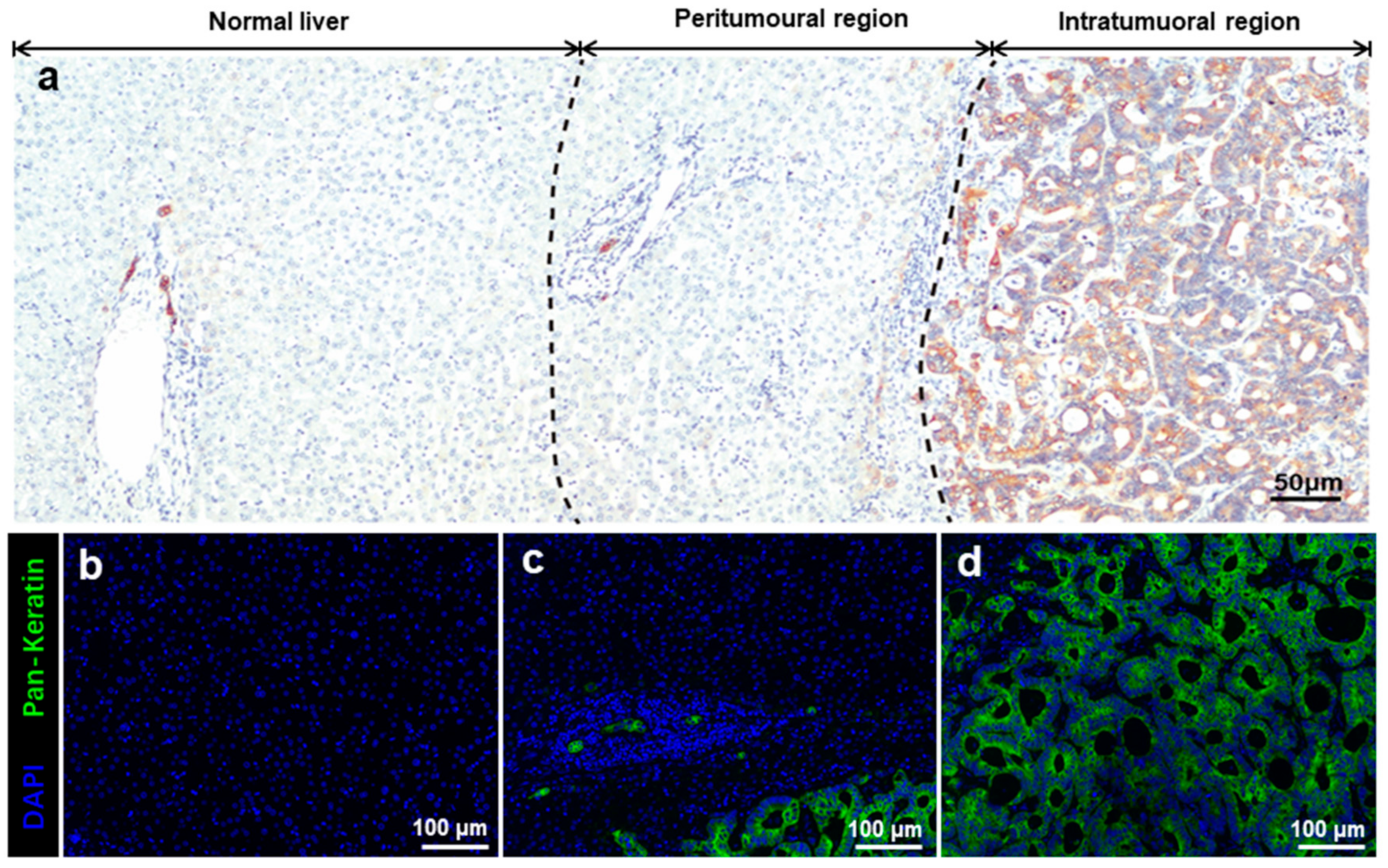
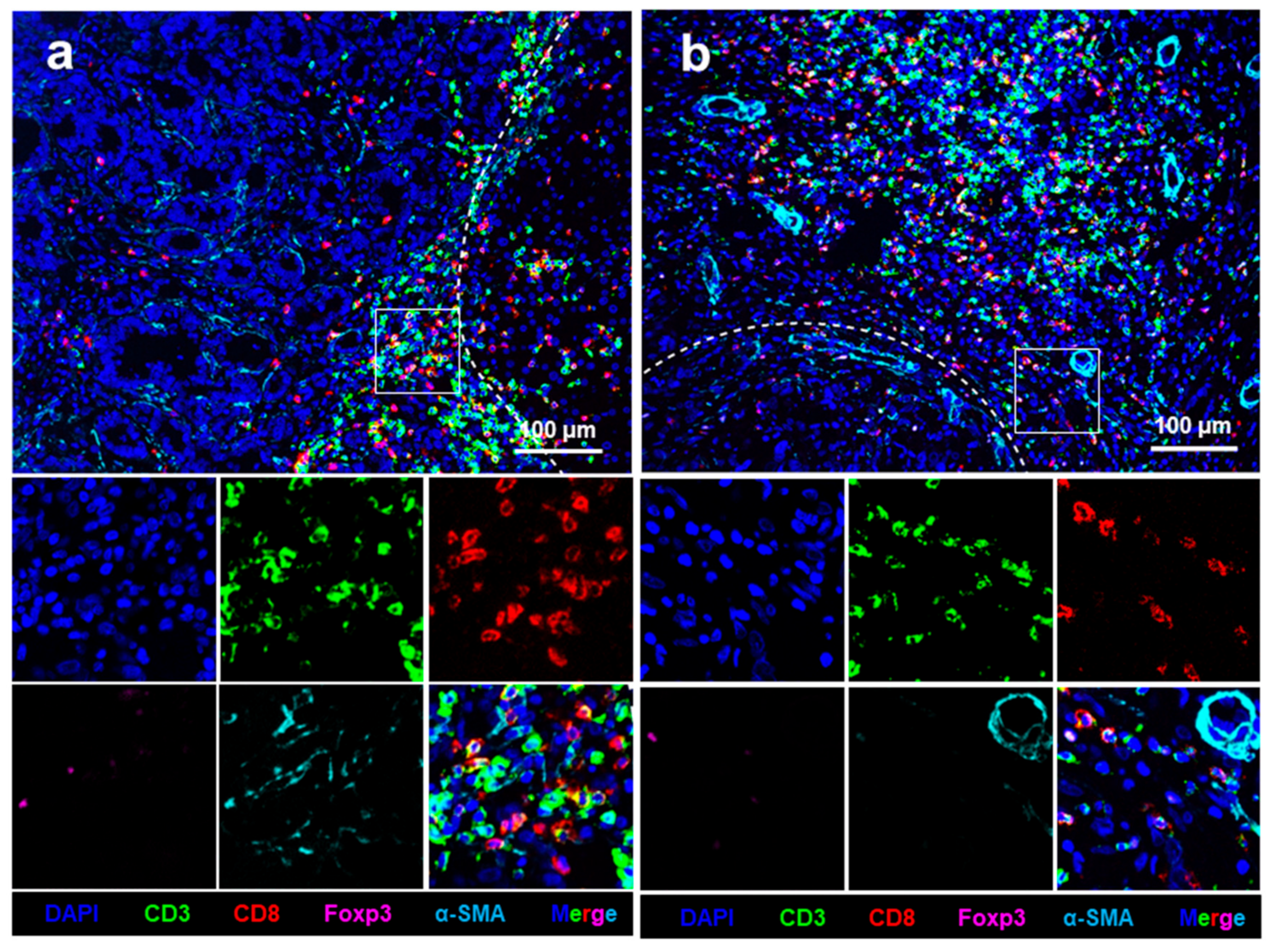
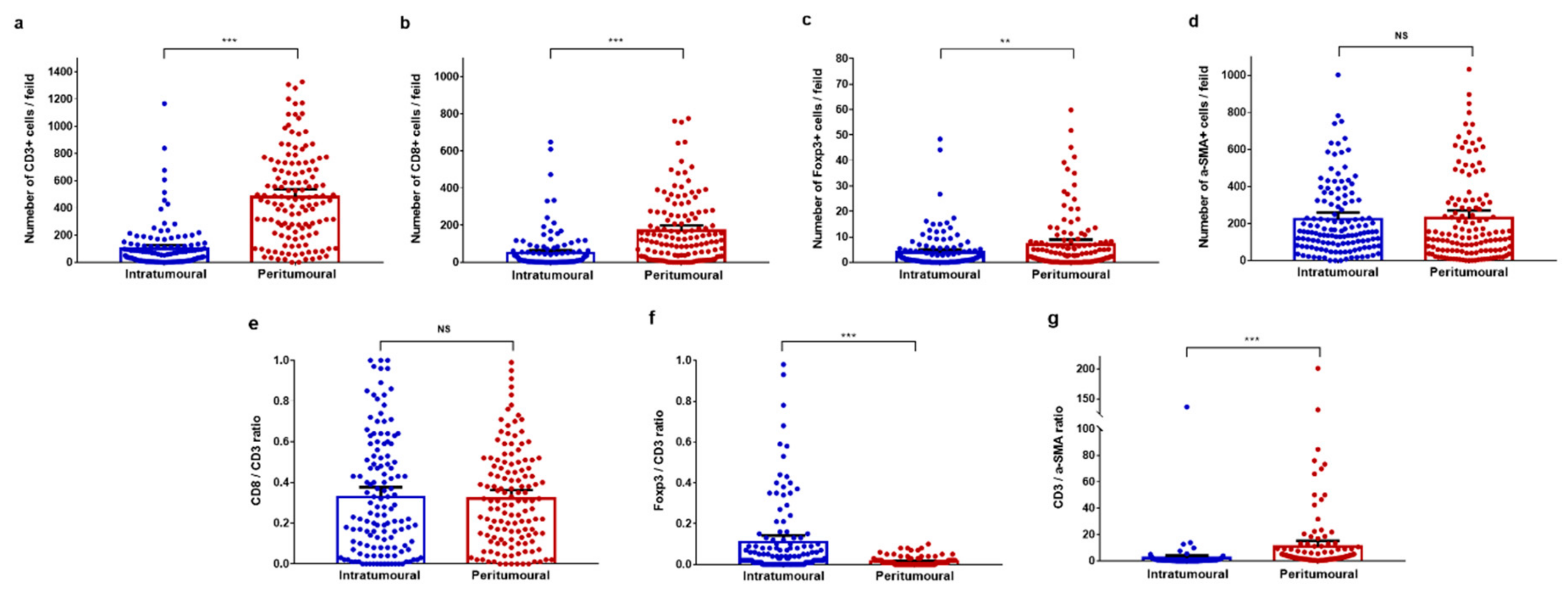
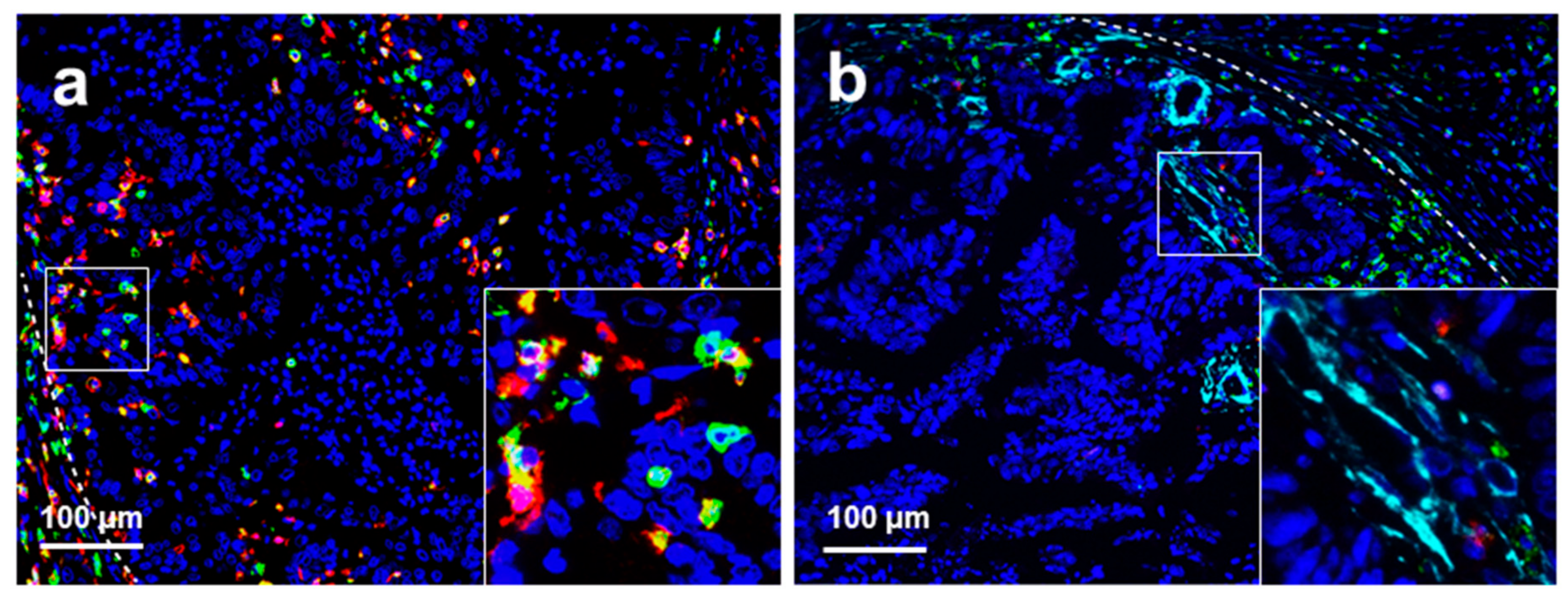
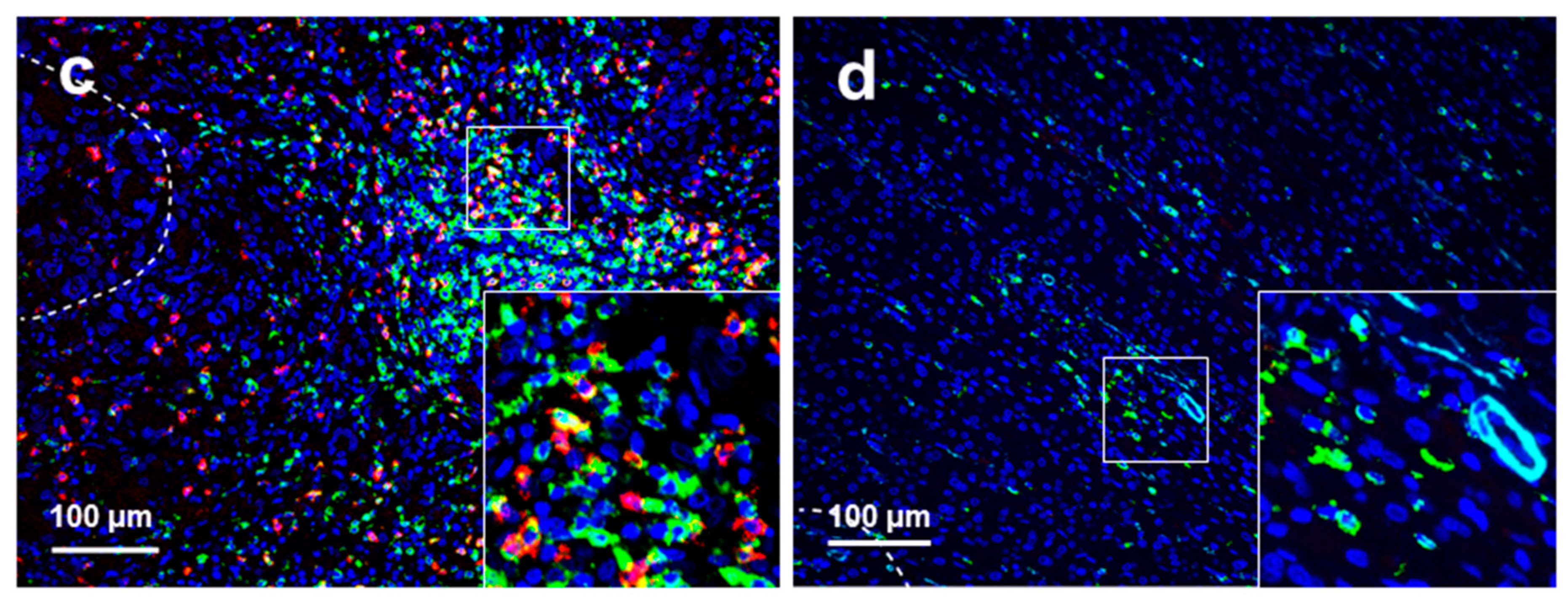
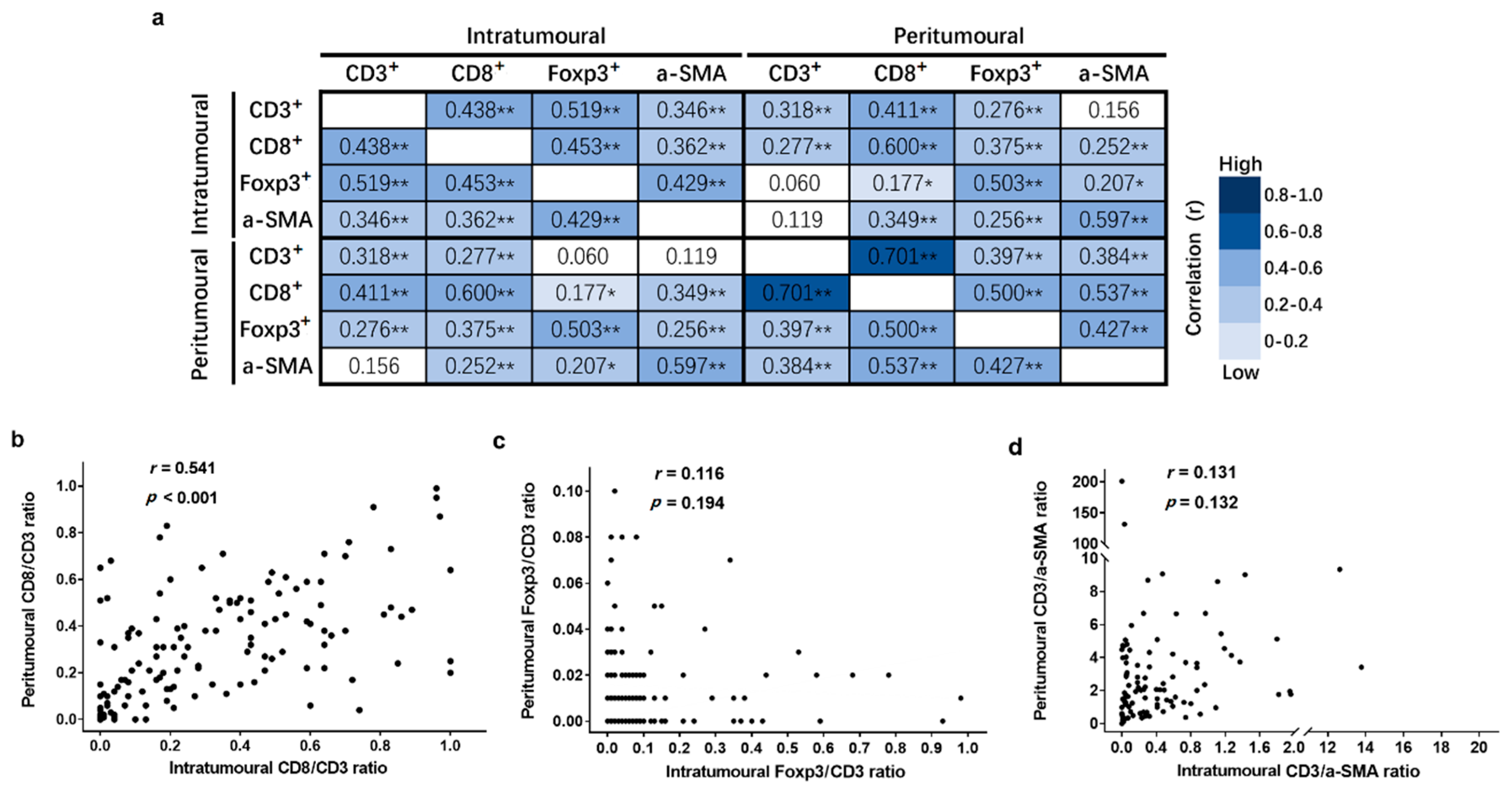
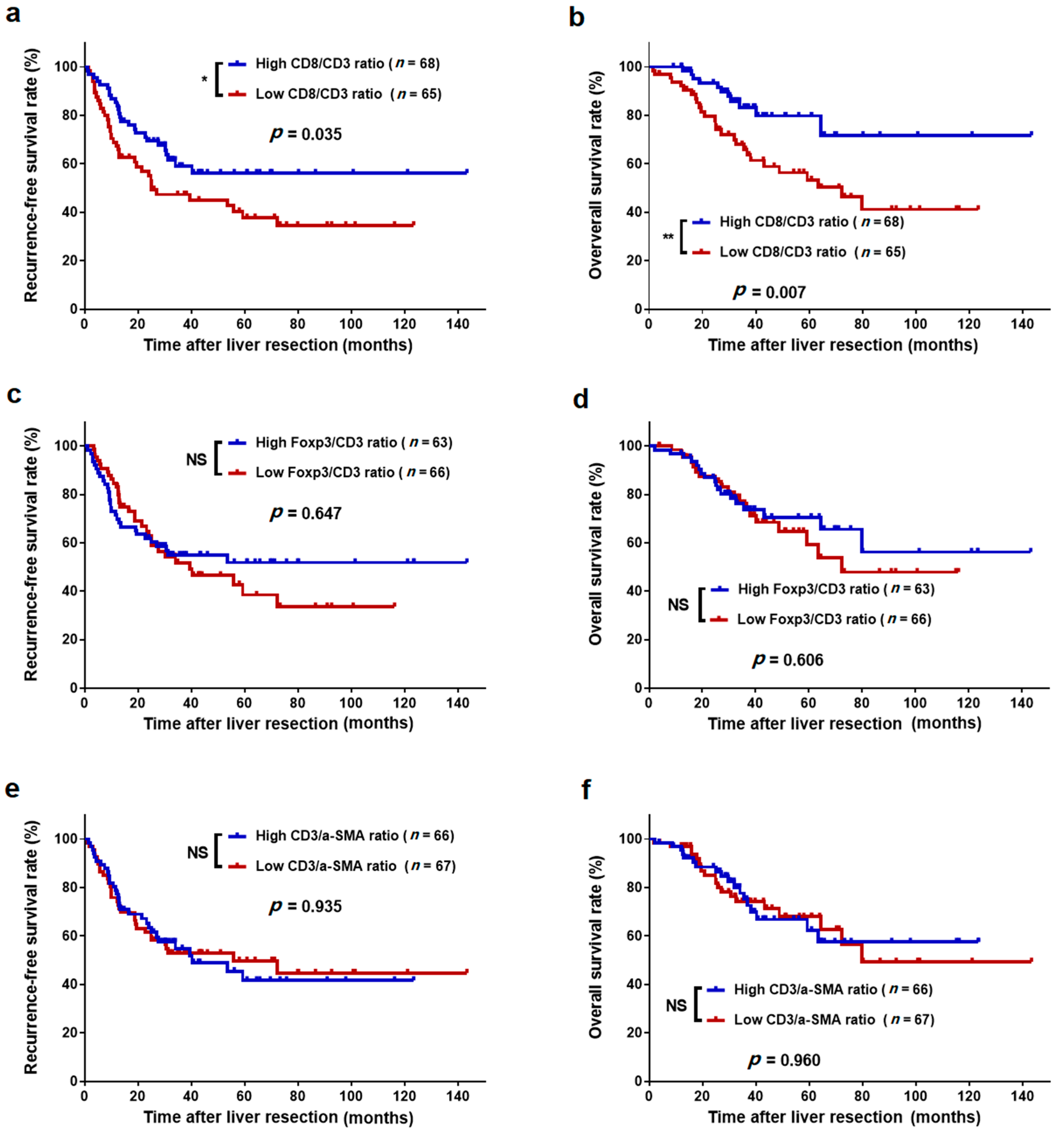
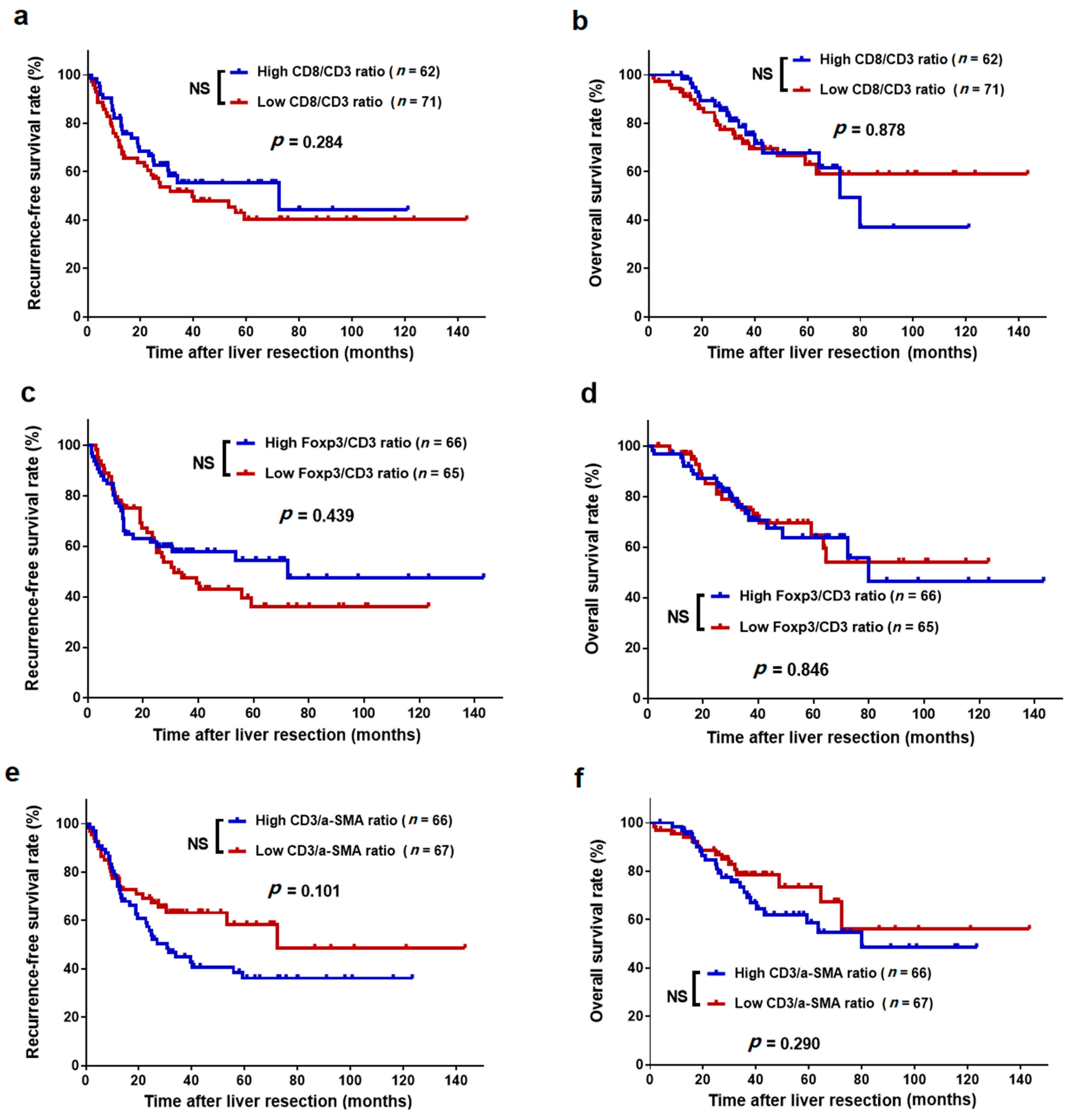
| Parameters | Total Patients (n = 133, %) |
|---|---|
| Patient characteristics | |
| Median age (years) | 57.8 (25–78) |
| Age, year | |
| ≤60 | 82 (61.7) |
| >60 | 51 (38.3) |
| Sex | |
| Male | 80 (60.2) |
| Female | 53 (39.8) |
| Hepatitis B virus infection | |
| Negative | 114 (85.7) |
| Positive | 19 (14.3) |
| Primary tumour location | |
| Right-side colon | 34 (25.6) |
| Left-side colon | 50 (37.6) |
| Rectum | 49 (36.8) |
| Primary tumour differentiation | |
| Well to moderate | 98 (73.7) |
| Poor | 35 (26.3) |
| T stage a | |
| 1–3 | 82 (61.7) |
| 4 | 51 (38.3) |
| N stage a | |
| 0 | 44 (33.1) |
| 1–2 | 89 (66.9) |
| Timing of metastasis | |
| Synchronous | 86 (64.7) |
| Metachronous | 47 (35.3) |
| Metastasis diameter (cm) | |
| Median (range) | 2.5 (0.3–12) |
| ≤3 | 93 (69.9) |
| >3 | 40 (31.1) |
| Median liver resection margin (cm) | 1.0 (0–3.5) |
| MSKCC-CRS | |
| 0 | 10 (7.5) |
| 1 | 49 (36.8) |
| 2 | 66 (49.6) |
| 3 | 7 (5.3) |
| 4 | 1 (0.8) |
| Adjuvant chemotherapy | |
| Oxaliplatin-based regimen | 72 (54.1) |
| Irinotecan-based regimen | 14 (10.5) |
| 5-Fu alone | 5 (3.8) |
| No | 42 (31.6) |
| CD8/CD3 Ratio | Foxp3/CD3 Ratio | CD3/α-SMA Ratio | ||||||||||||||||
|---|---|---|---|---|---|---|---|---|---|---|---|---|---|---|---|---|---|---|
| Intratumoural (n = 133) | Peritumoural (n = 133) | Intratumoural (n = 129) | Peritumoural (n = 131) | Intratumoural (n = 133) | Peritumoural (n = 133) | |||||||||||||
| Parameters | High (n, %) | Low (n, %) | p Value | High (n, %) | Low (n, %) | p Value | High (n, %) | Low (n, %) | p Value | High (n, %) | Low (n, %) | p Value | High (n, %) | Low (n, %) | p Value | High (n, %) | Low (n, %) | p Value |
| Age, year | 0.697 | 0.917 | 0.828 | 0.651 | 0.242 | 0.804 | ||||||||||||
| ≤60 | 42 (61.8) | 38 (58.5) | 37 (59.7) | 43 (60.6) | 37 (58.7) | 40 (60.6) | 28 (62.2) | 50 (58.1) | 43 (65.2) | 37 (55.2) | 39 (59.1) | 41 (61.2) | ||||||
| >60 | 26 (38.2) | 27 (41.5) | 25 (40.3) | 28 (39.4) | 26 (41.3) | 26 (39.4) | 17 (37.8) | 36 (41.9) | 23 (34.8) | 30 (44.8) | 27 (40.9) | 26 (38.8) | ||||||
| Sex | 0.297 | 0.936 | 0.880 | 0.576 | 0.337 | 0.641 | ||||||||||||
| Male | 39 (57.4) | 43 (66.2) | 38 (61.3) | 44 (62.0) | 39 (61.9) | 40 (60.6) | 26 (57.8) | 54 (62.8) | 38 (57.6) | 44 (65.7) | 42 (63.6) | 40 (59.7) | ||||||
| Female | 29 (42.6) | 22 (33.8) | 24 (38.7) | 27 (38.0) | 24 (38.1) | 26 (39.4) | 19 (42.2) | 32 (37.2) | 28 (42.4) | 23 (34.3) | 24 (36.4) | 27 (40.3) | ||||||
| Hepatitis B Virus infection | 0.103 | 0.670 | 0.176 | 0.441 | 0.229 | 0.777 | ||||||||||||
| Negative | 55 (80.9) | 59 (90.8) | 54 (87.1) | 60 (84.5) | 51 (81.0) | 59 (89.4) | 37 (82.2) | 75 (87.2) | 59 (89.4) | 55 (82.1) | 56 (84.8) | 58 (86.6) | ||||||
| Positive | 13 (19.1) | 6 (9.2) | 8 (12.9) | 11 (15.5) | 12 (19.0) | 7 (10.6) | 8 (17.8) | 11 (12.8) | 7 (10.6) | 12 (17.9) | 10 (15.2) | 9 (13.4) | ||||||
| Primary tumour location | 0.011 | 0.035 | 0.736 | 0.013 | 0.056 | 0.545 | ||||||||||||
| Colon | 50 (73.5) | 34 (52.3) | 45 (72.6) | 39 (54.9) | 40 (63.5) | 40 (60.6) | 35 (77.8) | 48 (55.8) | 47 (71.2) | 37 (55.2) | 40 (60.6) | 44 (65.7) | ||||||
| Rectum | 18 (26.5) | 31 (47.7) | 17 (27.4) | 32 (45.1) | 23 (36.5) | 26 (39.4) | 10 (22.2) | 38 (44.2) | 19 (28.8) | 30 (44.8) | 26 (39.4) | 23 (34.3) | ||||||
| Primary tumour differentiation | 0.044 | 0.289 | 0.809 | 0.098 | 0.153 | 0.520 | ||||||||||||
| Well to moderate | 45 (66.2) | 53 (81.5) | 43 (69.4) | 55 (77.5) | 47 (74.6) | 48 (72.7) | 29 (64.4) | 67 (77.9) | 45 (68.2) | 53 (79.1) | 47 (71.2) | 51 (76.1) | ||||||
| Poor | 23 (33.8) | 12 (18.5) | 19 (30.6) | 16 (22.5) | 16 (25.4) | 18 (27.3) | 16 (35.6) | 19 (22.1) | 21 (31.8) | 14 (20.9) | 19 (28.8) | 16 (23.9) | ||||||
| T stage a | 0.492 | 0.526 | 0.744 | 0.342 | 0.238 | 0.912 | ||||||||||||
| 1–3 | 40 (58.8) | 42 (64.6) | 40 (64.5) | 42 (59.2) | 39 (61.9) | 39 (59.1) | 30 (66.7) | 50 (58.1) | 44 (66.7) | 38 (56.7) | 41 (62.1) | 41 (61.2) | ||||||
| 4 | 28 (41.2) | 23 (35.4) | 22 (35.5) | 29 (40.8) | 24 (38.1) | 27 (40.9) | 15 (33.3) | 36 (41.9) | 22 (33.3) | 29 (43.3) | 25 (37.9) | 26 (38.8) | ||||||
| N stage a | 0.579 | 0.017 | 0.253 | 0.488 | 0.758 | 0.758 | ||||||||||||
| 0 | 24 (35.3) | 20 (30.8) | 27 (43.5) | 17 (23.9) | 17 (27.0) | 24 (36.4) | 13 (28.9) | 30 (34.9) | 21 (31.8) | 23 (34.3) | 21 (31.8) | 23 (34.3) | ||||||
| 1–2 | 44 (64.7) | 45 (69.2) | 35 (56.5) | 54 (76.1) | 46 (73.0) | 42 (63.6) | 32 (71.1) | 56 (65.1) | 45 (68.2) | 44 (65.7) | 45 (68.2) | 44 (65.7) | ||||||
| MSKCC-CRS | 0.771 | 0.862 | 0.057 | 0.068 | 0.655 | 0.426 | ||||||||||||
| 0–1 | 31 (45.6) | 28 (43.1) | 28 (45.2) | 31 (43.7) | 22 (34.9) | 34 (51.5) | 15 (33.3) | 43 (50.0) | 28 (42.4) | 31 (46.3) | 27 (40.9) | 32 (47.8) | ||||||
| 2–4 | 37 (45.6) | 37 (56.9) | 34 (54.8) | 40 (56.3) | 41 (65.1) | 32 (48.5) | 30 (66.7) | 43 (50.0) | 38 (57.6) | 36 (53.7) | 39 (59.1) | 35 (52.2) | ||||||
| Adjuvant chemotherapy | 0.188 | 0.595 | 0.084 | 0.574 | 0.953 | 0.421 | ||||||||||||
| No | 25 (36.8) | 17 (26.2) | 21 (33.9) | 21 (29.6) | 15 (23.8) | 25 (37.9) | 13 (28.9) | 29 (33.7) | 21 (31.8) | 21 (31.3) | 23 (34.8) | 19 (28.4) | ||||||
| Yes | 43 (63.2) | 48 (73.8) | 41 (66.1) | 50 (70.4) | 48 (76.2) | 41 (62.1) | 32 (71.1) | 57 (66.3) | 45 (68.2) | 46 (68.7) | 43 (65.2) | 48 (71.6) | ||||||
| Parameters | RFS | OS | ||||||
|---|---|---|---|---|---|---|---|---|
| Univariate | Multivariate | Univariate | Multivariate | |||||
| HR (95% CI) | p Value | HR (95% CI) | p Value | HR (95% CI) | p Value | HR (95% CI) | p Value | |
| Age (>60 years vs. ≤60 years) | 0.968 (0.582–1.610) | 0.901 | 1.264 (0.664–2.408) | 0.475 | ||||
| Sex (male vs. female) | 1.076 (0.647–1.789) | 0.778 | 0.888 (0.466–1.693) | 0.718 | ||||
| Primary tumour location (rectum vs. colon) | 1.302 (0.788–2.152) | 0.303 | 1.361 (0.718–2.581) | 0.345 | ||||
| Primary tumour differentiation (poor vs. well to moderate) | 1.327 (0.773–2.277) | 0.305 | 0.835 (0.382–1.824) | 0.652 | ||||
| T stage (4 vs. 1–3) | 1.341 (0.813–2.212) | 0.250 | 1.524 (0.802–2.896) | 0.199 | ||||
| N stage (1–2 vs. 0) | 1.844 (1.044–3.256) | 0.035 | 1.806 (1.018–3.202) | 0.043 | 1.922 (0.909–4.067) | 0.087 | 2.041(0.960–4.338) | 0.064 |
| Timing of metastasis (synchronous vs. metachronous) | 1.220 (0.718–2.074) | 0.463 | 1.245 (0.628–2.470) | 0.531 | ||||
| Metastases diameter (>3 cm vs. ≤3 cm) | 1.576 (0.943–2.634) | 0.083 | 1.533 (0.915–2.568) | 0.105 | 1.870 (0.986–3.547) | 0.055 | 1.738 (0.915–3.300) | 0.091 |
| Preoperative CEA (>50 ng/mL vs. ≤50 ng/mL) | 1.477 (0.810–2.694) | 0.204 | 1.796 (0.878–3.674) | 0.109 | ||||
| Adjuvant chemotherapy (yes vs. no) | 1.794 (0.973–3.307) | 0.061 | 1.666 (0.900–3.081) | 0.104 | 1.567 (0.688–3.570) | 0.285 | ||
| Intratumoural CD8/CD3 ratio (high vs. low) | 0.585 (0.353–0.968) | 0.037 | 0.593 (0.357–0.985) | 0.043 | 0.392 (0.193–0.793) | 0.009 | 0.391 (0.193–0.794) | 0.009 |
© 2019 by the authors. Licensee MDPI, Basel, Switzerland. This article is an open access article distributed under the terms and conditions of the Creative Commons Attribution (CC BY) license (http://creativecommons.org/licenses/by/4.0/).
Share and Cite
Peng, J.; Wang, Y.; Zhang, R.; Deng, Y.; Xiao, B.; Ou, Q.; Sui, Q.; Xu, J.; Qin, J.; Lin, J.; et al. Immune Cell Infiltration in the Microenvironment of Liver Oligometastasis from Colorectal Cancer: Intratumoural CD8/CD3 Ratio Is a Valuable Prognostic Index for Patients Undergoing Liver Metastasectomy. Cancers 2019, 11, 1922. https://doi.org/10.3390/cancers11121922
Peng J, Wang Y, Zhang R, Deng Y, Xiao B, Ou Q, Sui Q, Xu J, Qin J, Lin J, et al. Immune Cell Infiltration in the Microenvironment of Liver Oligometastasis from Colorectal Cancer: Intratumoural CD8/CD3 Ratio Is a Valuable Prognostic Index for Patients Undergoing Liver Metastasectomy. Cancers. 2019; 11(12):1922. https://doi.org/10.3390/cancers11121922
Chicago/Turabian StylePeng, Jianhong, Yongchun Wang, Rongxin Zhang, Yuxiang Deng, Binyi Xiao, Qingjian Ou, Qiaoqi Sui, Jing Xu, Jiayi Qin, Junzhong Lin, and et al. 2019. "Immune Cell Infiltration in the Microenvironment of Liver Oligometastasis from Colorectal Cancer: Intratumoural CD8/CD3 Ratio Is a Valuable Prognostic Index for Patients Undergoing Liver Metastasectomy" Cancers 11, no. 12: 1922. https://doi.org/10.3390/cancers11121922
APA StylePeng, J., Wang, Y., Zhang, R., Deng, Y., Xiao, B., Ou, Q., Sui, Q., Xu, J., Qin, J., Lin, J., & Pan, Z. (2019). Immune Cell Infiltration in the Microenvironment of Liver Oligometastasis from Colorectal Cancer: Intratumoural CD8/CD3 Ratio Is a Valuable Prognostic Index for Patients Undergoing Liver Metastasectomy. Cancers, 11(12), 1922. https://doi.org/10.3390/cancers11121922





